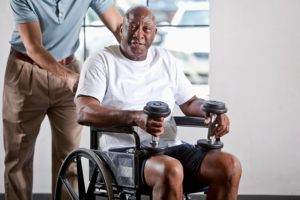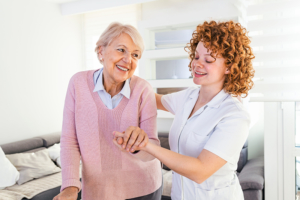Why Strength Training for Seniors Is Imperative Post-Pandemic
 As we’re finally easing our way out of this pandemic, we’re finding more about how it has harmed senior loved ones – both physically and emotionally. We know older adults have been at a higher threat of serious issues and death due to the COVID-19 virus, although the impact of 15 months of social isolation and physical distancing is similarly distressing.
As we’re finally easing our way out of this pandemic, we’re finding more about how it has harmed senior loved ones – both physically and emotionally. We know older adults have been at a higher threat of serious issues and death due to the COVID-19 virus, although the impact of 15 months of social isolation and physical distancing is similarly distressing.
Dr. Jonathan Bean of the New England Geriatric Research, Education and Clinical Center at the Veterans Affairs Boston Healthcare System has noticed a “significant decline in functioning” in both his elderly patients and his own mother. Whereas she had been able to walk with the assistance of a walker, be involved in conversations, and participate in other activities of day-to-day life independently pre-pandemic, her self-care and cognitive abilities have diminished dramatically.
Physical therapy Linda Teodosio confirms, explaining, “Immobility and debility are outcomes to this horrific pandemic that people aren’t even talking about yet.” She is noticing a considerable uptick in both falls and chronic disease exacerbation – likely based on poor lifestyle choices due to the pandemic, such as unhealthy food intake and reduced exercise.
As a result, increasingly more older adults require physical therapy as well as other rehabilitative services. Some health plans are addressing the issue by following up with seniors to confirm their wellbeing and also to help connect them to the services they require to restore their strength. Surprisingly, as much as 20% of an older adult’s muscle mass may be lost by just not walking for up to five days, according to physical therapist Sabaa Mundia.
Before leaping into a new exercise routine, however, it’s essential that seniors first schedule an appointment with the physician for a complete exam and recommendations on safe, ability-appropriate exercise. Then make a plan to help the seniors in your life to follow a healthier lifestyle that includes a good amount of exercise.
Let Responsive Home Care help the seniors in your life stay as physically active and engaged as possible to remain strong post-pandemic. Our home caregivers are always on hand to supply the motivation and encouragement to help seniors make physical activity a routine part of every day. We are able to also provide accompaniment to exercise classes, the fitness center, the pool – wherever and whenever a senior wishes to go. Sometimes, just adding in a regular walk with one of our friendly caregivers can make a world of difference in how older adults feel!
Contact us for a free in-home consultation to learn more about how we can help.

